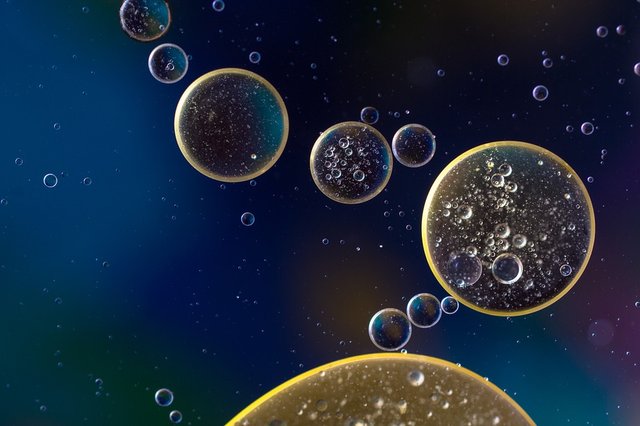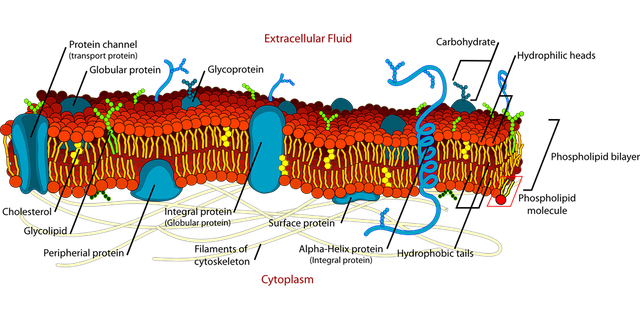The shape of nanomedicine
There is a thin line between life and everything else. The line is thinner than you think. About 4-5 nm if we want to be precise. Bilayers of lipids held together by non-covalent interactions, prevent molecules and ions from moving freely in and out of the barrier (Nicolson 2014). Inside this barrier, segregated in this chemically distinct environment, there is a complex machinery in which proteins and nucleic acids are the cogs fueled by the breakdown of sugars. That was a long way to introduce a cell and its plasma membrane.
Today I want to talk briefly about how molecules diffuse inside the cells, how virus and bacteria evolved to favor or to avoid cell internalization and how we can use take inspiration from nature to design nanomedicine.
Since there would be a ton of things to say about each of the topics I will touch in this post, I decided to just cover them briefly, otherwise I would end up writing a book and not a post.
If the cell membrane was composed only of lipids, the transport of molecules in and out would be extremely difficult. Luckily, we also have transmembrane proteins. Some of these proteins act literally as pumps, selectively allowing ions in and out of the cells, while other proteins enable the cross-talk between the cell and the external environment. These proteins are called receptors, and figuratively speaking, are the eyes and ears of the cells since they use them to figure out what’s going on nearby.
When a cell ingests macromolecules we are talking about endocytosis, while when cells “spit-out” macromolecules we are talking about exocytosis. There are different types of endocytosis, to use an analogy, we can say pinocytosis is the cellular equivalent of “drinking” while phagocytosis is the equivalent of “gulping down” in this case large particles.
With the term pinocytosis we are including the terms macropinocytosis, clathrin and caveolin-mediated endocytosis and all the mechanisms that allow the cells to “swallow” entities smaller than 150 nm (Conner and Schmid 2003).
With the term phagocytosis we describe the ingestion of large entities, larger than 250 nm. Generally, this task is performed by specialized cells like macrophages, dendritic cells and neutrophils with the aim of clearing cell debris and get rid of microorganisms that tried to sneak in our body.
Adapted with permission from reference (Kinnear et al. 2017). Copyright 2017 American Chemical Society (Screenshot of permission at the bottom of the post)
Before moving on to other concepts I just wanted to quickly point out that also the speed of these mechanism of endocytosis is also different, for example caveolin-mediated endocytosis, used for transporting proteins of the serum, is slow while clathrin-mediated endocytosis is a form of receptor-mediated endocytosis and is fast (Kinnear et al. 2017).
However, ions and small molecules are not the only things to enter the cells. There are microorganisms that evolved special features that enable them to bypass cells defense mechanisms and “sneak” inside too. I am talking about viruses for example. We have viruses of all sort of size and shapes and if Darwin taught us something is that if viruses or bacteria of a certain shape were selected and survived for all this time, they must have had a good reason (Cui et al. 2016).
Indeed, studies found significant links between shape and biological activity of particles, shape was found to determine uptake, biodistribution, toxicity and inflammatory response of particles (Wang et al. 2011).
Several types of viruses need to be internalized in order to infect a cell, and some of the most conducive shapes to cell internalization are the spherical and icosahedral.
Adapted with permission from reference (Kinnear et al. 2017). Copyright 2017 American Chemical Society (Screenshot of permission at the bottom of the post)
If we look at bacteria instead, we can see a vast variety of shapes, from spherical to rod-like. Here, we must consider that the most energetically favorable shape would be spherical. It is expensive for a bacteria to maintain a rod shape because it will go against the internal osmotic pressure, this means that if today we have bacteria with a rod shape they must have something to gain from it.
In fact, most bacteria do not want to be taken up by mammalian cells, instead, they want to stay outside, be able to move efficiently and get the nutrients they need.
Effective uptake of nutrients is crucial for survival of bacteria and the shape that would maximize this would be a thin-disc shape. Yet, we don’t see many bacteria shaped like a disc, why? For instance, some studies found that bacteria that have a filament shape like for example Legionella pneumophila, are very hard to kill for our “professional phagocytes”, that’s because they are difficult to engulf compared to spherical bacteria (Horvath et al. 2011; Young 2006).
Other shapes like for example helical, were found to favor bacteria movement in viscous environments, like the ones that can be found in the intestinal mucus (Lee et al. 1986).
What about the rods?
Well, some think that this was the shape of the first bacteria that appeared on our planet (Koch 2003). The biological activity of rod-shaped microorganisms depends on their size, in fact it was found that rod longer than 500 nm are extremely difficult for cells to engulf, while rods smaller than 300 nm are actually easier to internalize compared to spheres (Kinnear et al. 2017). It’s no coincidence that the tobacco mosaic virus, that has a rod-shape, is 300 x 18 nm. However, rods have other advantages as well, rod-shaped bacteria have better motility and also can more easily attach to surfaces under flow because they minimize the shear stress by orienting themselves (Shen et al. 2012).
Adapted with permission from reference (Kinnear et al. 2017). Copyright 2017 American Chemical Society (Screenshot of permission at the bottom of the post)
Ok..you may say, all this is interesting but so what?
In many instances, it would be desirable to deliver drugs directly inside the cells, let’s just think about killing cancer cells for example or being able to do gene therapy effectively. We know that using particles as vehicle for drugs has several advantages like prolonged effects, longer shelf-life and controlled delivery. However, today we learned a lot about particles and especially how to make them of different shapes.
Some of the shapes of particles we can design today. Adapted with permission from reference (Kinnear et al. 2017). Copyright 2017 American Chemical Society (Screenshot of permission at the bottom of the post)
We can easily make rods, discs or spheres. Nature has already done a lot of work for us and simply by observing the evolutionary advantages of microorganisms and their shape we can estimate the right shape of particles to use in different applications.
There is more to say but it’s 2 am already so I will wrap it up here because I can’t keep my eyes open and I ran out of coffee so my brain started the shut down procedure..3 2 1…beeeeep
References
- Conner, Sean D, and Sandra L Schmid. 2003. “Regulated Portals of Entry into the Cell.” Nature 422(6927): 37–44. http://www.ncbi.nlm.nih.gov/pubmed/12621426.
- Cui, Jiwei et al. 2016. “Nanoengineered Templated Polymer Particles: Navigating the Biological Realm.” Accounts of chemical research 49(6): 1139–48. http://www.ncbi.nlm.nih.gov/pubmed/27203418.
- Horvath, Dennis J et al. 2011. “Morphological Plasticity Promotes Resistance to Phagocyte Killing of Uropathogenic Escherichia Coli.” Microbes and infection 13(5): 426–37. http://www.ncbi.nlm.nih.gov/pubmed/21182979.
- Kinnear, Calum et al. 2017. “Form Follows Function: Nanoparticle Shape and Its Implications for Nanomedicine.” Chemical reviews 117(17): 11476–521. http://www.ncbi.nlm.nih.gov/pubmed/28862437.
- Koch, Arthur L. 2003. “Were Gram-Positive Rods the First Bacteria?” Trends in microbiology 11(4): 166–70. http://www.ncbi.nlm.nih.gov/pubmed/12706994.
- Lee, A, J L O’Rourke, P J Barrington, and T J Trust. 1986. “Mucus Colonization as a Determinant of Pathogenicity in Intestinal Infection by Campylobacter Jejuni: A Mouse Cecal Model.” Infection and immunity 51(2): 536–46. http://www.ncbi.nlm.nih.gov/pubmed/2935499.
- Nicolson, Garth L. 2014. “The Fluid-Mosaic Model of Membrane Structure: Still Relevant to Understanding the Structure, Function and Dynamics of Biological Membranes after More than 40 Years.” Biochimica et biophysica acta 1838(6): 1451–66. http://www.ncbi.nlm.nih.gov/pubmed/24189436.
- Shen, Yi et al. 2012. “Flow Directs Surface-Attached Bacteria to Twitch Upstream.” Biophysical journal 103(1): 146–51. http://www.ncbi.nlm.nih.gov/pubmed/22828341.
- Wang, Jin, James D Byrne, Mary E Napier, and Joseph M DeSimone. 2011. “More Effective Nanomedicines through Particle Design.” Small (Weinheim an der Bergstrasse, Germany) 7(14): 1919–31. http://www.ncbi.nlm.nih.gov/pubmed/21695781.
- Young, Kevin D. 2006. “The Selective Value of Bacterial Shape.” Microbiology and molecular biology reviews : MMBR 70(3): 660–703. http://www.ncbi.nlm.nih.gov/pubmed/16959965.
Permission from reference (Kinnear et al. 2017)
Immagine CC0 Creative Commons, si ringrazia @mrazura per il logo **ITASTEM**. **CLICK HERE AND VOTE FOR DAVINCI.WITNESS**
Logo created by @vogliofatti









Interesting one @aboutcoolscience
I totally agreed that nature has everything to teach us If we just want to...
And to make the nanoparticles for applications such as drug delivery or working as nanomedicines, one can try different shapes and bacteria do suggests which shape can be best. What I think is making the drug or particle round shape will give you more surface and hence more effective also...
Write more on nanoscience I would love to read them all.
Cheers😊
Thank you for your comment, certainly I will keep it in mind when planning my next posts :)
Should we then ignore references that come later?
ahahah no, I found those before writing the post :)